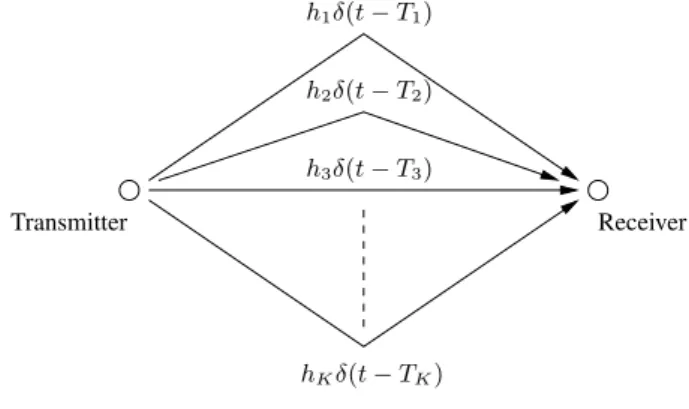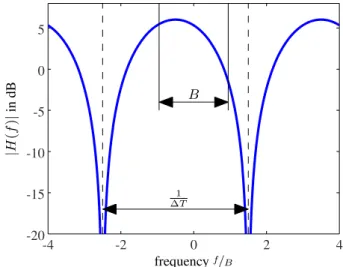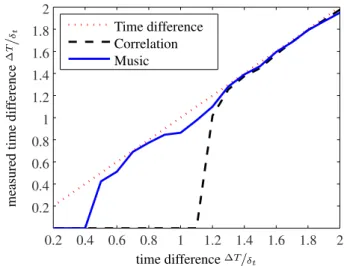www.adv-radio-sci.net/8/61/2010/ doi:10.5194/ars-8-61-2010
© Author(s) 2010. CC Attribution 3.0 License.
Radio Science
High resolution time of arrival estimation for a cooperative sensor
system
C. Morhart and E. M. Biebl
Fachgebiet H¨ochstfrequenztechnik, Technische Universit¨at M¨unchen, Munich, Germany
Abstract. Distance resolution of cooperative sensors is lim-ited by the signal bandwidth. For the transmission mainly lower frequency bands are used which are more narrowband than classical radar frequencies. To compensate this resolu-tion problem the combinaresolu-tion of a pseudo-noise coded pulse compression system with superresolution time of arrival es-timation is proposed. Coded pulsecompression allows se-cure and fast distance measurement in multi-user scenarios which can easily be adapted for data transmission purposes (Morhart and Biebl, 2009). Due to the lack of available signal bandwidth the measurement accuracy degrades especially in multipath scenarios. Superresolution time of arrival algo-rithms can improve this behaviour by estimating the channel impulse response out of a band-limited channel view. For the given test system the implementation of a MUSIC algorithm permitted a two times better distance resolution as the stan-dard pulse compression.
1 Introduction
For security systems and a number of logistic applications the combination of clear identification and exact localization is a vital task. Actions and reactions can only be taken if the classification of the target is assured. Cooperative sen-sors are therefore a key technology as the use of active target transponders offers an easy identification by the transponder signal. Furthermore, the communication between coopera-tive sensors can even be established in difficult communica-tion scenarios when there’s no line of sight. This property is dependent on the transmission frequency and it was shown (Fackelmeier et al., 2008) that lower frequencies are advan-tageous for the detection of visually hidden objects. Never-theless, bandwidth is limited for lower frequencies like ISM
Correspondence to:C. Morhart (morhart@tum.de)
bands, which are additionaly used by other applications like data transmission. In Morhart and Biebl (2009) a distance measurement system was presented for the protection of vul-nerable road users in city scenarios. With this approach in the 2.4 GHz band highly accurate results for line of sight scenar-ios could be achieved. On the other side, this system offered a path resolution of only 5 m unidirectionally and respec-tively 2.5 m bidirectionally. For the time of arrival (ToA) esti-mation, the fastest path is also the most important one. Thus, in multipath scenarios with limited resolution a distance error can result because of unresolvable signal arrivals. This is es-pecially disadvantageous in non line of sight scenarios where several comparable strong transmission links occur. A pos-sibility to improve this bandwidth problem is with superres-olution ToA estimation (Krim and Viberg, 1996). Here, the complete channel impulse response is predicted out of a ban-dlimited channel view by superimposing a specific channel model. It has been shown in (Manolakis et al., 2000) that es-pecially eigenstructure based methods like MUSIC and ES-PRIT show superior performance. In combination with bi-phase modulated pulse compression the approach of (Du-mont et al., 1994) is advantageous. Therein a MUSIC im-plementation for a CDMA based system is described. This method could easily be adapted for the cooperative distance measurement system from Morhart and Biebl (2009).
2 System model
code Autocorrelation
time
Fig. 1.Schematic capture of biphase modulated pulse compression.
2.1 Round trip time of flight
The round trip time of flight (RToF) method resembles the classical radar principle. A signal transmitted by the car is received at the pedestrian side and sent back after a finite waiting timeTw. By knowing the waiting time the car can compute the distance1sout of the timeTppassed since the start of transmission.
1s=1T 2 c0=
Tp−Tw
2 c0 (1)
The advantage of this method is that no absolute time syn-chonization is needed but only a relative one to determine the exact delay time.
2.2 Pulse compression
High precision distance measurement and insensitivity to noise require a high Signal to Noise Ratio (SNR). With lim-ited output power a possible way to increase this ratio is by introducing pulse compression. This method raises the pulse energy by spreading signal information in time domain at constant amplitude and bandwidth (Skolnik, 2001). The energy-gain is due to a larger time bandwidth product that results equivalently in a slower measurement process com-pared to a single pulse system. An additional advantage of pseudo noise coded pulse compression is a differentiation of multi-user by applying different transmit codes. The ToA is then determined by correlating the received signal with the appropriate code (cf. Fig. 1). In that way the energy of the code sequence is compressed onto the autocorrelation peak, leading to a SNR gain in the ratio of the compression factor. 2.3 Multipath resolution
A key property of cooperative sensor technology is that tar-get interference can be avoided by using signal multiplexing techniques like time division multiple access or frequency di-vision multiple access. Nevertheless, each signal of an active transponder can still generate multipath interference due to reflections and diffractions on obstacles in the transmission path. The superposition of these signals leads to different correlation maxima in a pulse compression. The minimum distance between two signals which can still be distinguished is called multipath resolution. In the classical approach the ToA is defined by the correlation peak. Thus, the width of
Resolution
Path 1 Path 2
δt
t
1/B
Fig. 2.Resolution between 2 multipath with different time delay.
h1δ(t−T1)
h2δ(t−T2)
h3δ(t−T3)
hKδ(t−TK)
Transmitter Receiver
Fig. 3.Channel model.
correlation maximum is proportional to the resolution (cf. Fig. 2). For the case of pulse modulated signal transmis-sion, this resolution can be estimated by the pulse bandwidth (Haykin, 1995):
δt= 1
B (2)
As signal bandwidth is limited for lower frequency bands, classical multipath resolution is comparatively large. 2.4 Channel model
For signal transmission in city scenarios, multipath propaga-tion because of reflecpropaga-tion and diffracpropaga-tion on obstacles has to be regarded (cf. Fig. 3). In dependency on the surroundings there areKmultipaths having different time delayTk∈IR+0 and different path attenuationhk∈C. Therefore, the received signal consists ofKreplicas of the same signal. Accordingly, the continuous channel impulse response is defined by:
h(t )= K X
k=0
hkδ(t−Tk) (3) The complex channel impulse factor hk incorporates the channel attenuation and the channel phase variation, which can be assumed randomly distributed between[0,2π]. This channel transfer function can be described as a sum of complex exponentials in frequency domain:
H (f )= K X
k=0
Different path delays Tk correspond to different oscilla-tion periods, whereas the oscillaoscilla-tion phase is randomly dis-tributed. With this channel model a time domain peak search can be changed into the determination of the oscillation pe-riod in frequency domain. For this task several superresolu-tion algorithms are available (Krim and Viberg, 1996). For the pedestrian protection system the MUSIC algorithm was chosen because of its superior performance even with low SNR.
2.5 MUSIC Algorithm
The MUSIC Algorithm is based on a signal model consisting of a sum of harmonic signals and noise (Schmidt, 1986).
x[n] = K X
k=0
αkej ωkn+η[n] (5)
Each harmonic function is characterized by a complex am-plitudeαk∈C and an oscillation frequency ωk∈IR. η[n] corresponds to the additional noise. This relation can be ex-pressed in matrix-vector notation as:
x= K X
k=0
αkv(ωk)+η (6)
x= [x[0],x[1],...,x[N−1]]T is the N×1 data vector, v(ω)= [1,ej ω,...,ej (N−1)ω]T theN×1 complex phase
vec-tor andηthe noise vector. By building the autocorrelation
matrixRxx the correlation result can be divided into the in-formation partRssand the noiseRη.
Rxx=Rss+Rη (7)
Rss= K X
k=0
|hk|2v(ωk)vH(ωk) (8)
The matrix dimension forRxxisP×P withP≤N.P=N means maximum resolution, whereas P ≪N means more redundancy and less computational costs. The noise corre-lation matrix in the case of white noise is a diagonal-matrix with
Rη=ση2E. (9)
In the case ofK < P, The eigenvalue decomposition results in K signal and noise eigenvalues and P−K pure noise eigenvalues.
λp=P|hp|2+ση2 for p≤K (10)
λp=ση2 for K < p≤P (11) According to these eigenvalues there areP signal- andP−K
noise-eigenvectors.
Qs= [q1,q2,...,qK]T (12) Qη= [qK+1,...,qP]T (13)
C(f) H(f) C∗(f) 1
|C(f)|2 X(f) R(f) Φ(f)
Channel Pulse compression Deconvolution
Fig. 4.Idealized schematic of signal processing chain.
Because of the conjugate transposed structure of the corre-lation matrix all eigenvectors are orthogonal, i.e. Qs⊥Qη. Therefore signal information hkv(ωk) is a linear combina-tion ofQs and orthogonal toQη. This property can be used to determine the signal frequencies ωk. The magnitude of the scalar product with a noise eigenvector|v(ω)·qη|is min-imum ifω=ωkandv(ωk)a signal vector. Thus, the MUSIC pseudospectrum can be defined as the reciprocal of the sum of scalar products with all noise eigenvectors.
R(ω)= 1 P P p=K+1
|v(ω)·qp|2
(14)
3 System implementation
Harmonic functions plus noise are the initial point of the MUSIC algorithm. This model matches with the channel transfer function in frequency domain. Thus, for the imple-mentation of this superresolution algorithm a reconstruction of the channel transfer function is necessary. In a bi-phase modulated pulse compression system this is possible by de-convolving with the autocorrelation function. Figure 4 shows an illustration for a baseband transmission without nonlinear-ities and model errors. Following, the stages of ToA deter-mination will be explained.
3.1 Correlation
Pulse compression or equivalently signal correlation can be carried out in time or frequency domain. In time domain correlation can be achieved with a FIR Filter structure, in frequency domain with a scalar product of frequency vectors.
ϕ[n] =X N
c[n]r∗[n+N] (15)
8[m] =C[m]R∗[m] (16) The latter one is computational cost-saving especially for long code sequences. The SNR of the correlation output is also dependent on the code lengthLc.
SNRk=
2|hk|2LcEp
N0
(17)
3.2 Deconvolution
For optimum performance of superresolution algorithms a maximum similarity between real communication and the chosen signal model is needed. The pure correlation result is therefore not suited as additional components like corre-lation pulse form, spectral filter characteristics or hardware nonlinearities are also included. The goal is to cancel those parts out of the received signal. This method is called De-convolution and carried out by a division with the correlation power density.
X[m] = 8[m]
|C[m]|2≈H[m] (18)
With the neglect of model nonidealities, this result matches with the channel impulse response. In a real implementa-tion not only the correlaimplementa-tion pulse form but also spectral filter charactersitics should be compensated. In this context, dig-ital filters are advantegeous as the filter coefficients can be exactly known on transmitter and receiver side.
3.3 MUSIC implementation
For the computation of the MUSIC pseudospectrum the pa-rameterP andK have to be determined. P describes the dimension ofRxxand is therefore a degree for the frequency aperture of the algorithm (Manolakis et al., 2000). Thus larger values ofP have better resolution capabilities whereas smaller values result in more signal averaging and less vari-ations in the determination of noise eigenvalues. Another convenient characteristic of smaller values ofP is a decreas-ing computational effort. In the literature there’s no optimal solution for the relation ofP toN with values ranging from
P∈ [N/3,3N/5](Li and Pahlavan, 2004). With regard to sig-nal processing costs for mobile transponder P=N/3 was chosen.
Another important point is the estimation of the included signal componentsK. This can be done with the result of the eigenvalue decomposition. In the case of an adequate SNR ratio, signal eigenvalues outrange noise eigenvalues. Hence, there’s a detectable step between signal and noise subspace. For the following section, especially the caseK=2 was ex-amined.
4 Verification
The benefit of superresolution algorithms for cooperative sensor technology lies in an increase of ToA resolution. This improvement is possible because of the reconstruction of a limited channel view with an assumed signal model. Never-theless the detected channel information and thus the signal bandwidth has still a deciding influence on the quality of this method.
B
1 ∆T
frequencyf/B
|
H
(
f
)
|
in
dB
-4 -2 0 2 4
-20 -15 -10 -5 0 5
Fig. 5. Magnitude of|H (f )|for time difference1T=1/4δt and
1ϕ=−π/4.
4.1 Channel information
At first the available channel information should be analyzed. For superresolution ToA determination only scenarios with at least two transmission paths and time difference1T smaller than the classical resolutionδtare interesting. Figure 5 shows the spectral magnitude of a channel transfer function for the case of a two path transmission with a time difference of 1T =1/4δt and a phase difference of 1ϕ=−π/4. The detectable channel spectrum is limited by the transmission bandwidthB, so that only a small section of the channel in-formation is visible. This section is furthermore dependent on the phase difference which can be assumed randomly dis-tributed between1ϕ∈ [0,2π]. As a consequence the super-resolution results are connected to the position of the channel extract. If concentrated at a fading point, the SNR and thus the quality of channel reconstruction is degrading. Hence, the influence of the SNR on the MUSIC resolution was in-vestigated.
4.2 Simulation of multipath resolution
For the determination of the resolution boundary a simula-tion with a two path transmission with variable time dif-ference and SNR was executed. Transmission parameters were chosen according to the proposed cooperative sensor system from Morhart and Biebl (2009) with 256 Bit long m-sequences and a two times oversampling receiver. The phase difference was assumed randomly distributed between [0,2π]. Figure 6 shows the resolution boundary for the MU-SIC and the correlation ToA determination. The correlation boundary is according to Eq. (2) at 1T =δt with two re-solved paths for1T > δt.
time difference∆T/δt
SNR
in
dB
MUSIC Correlation
2
path
res.
2 path res.
1 path res.
0 0.2 0.4 0.6 0.8 1 1.2
-10 0 10 20 30 40 50
Fig. 6.Simulation of resolution boundary for two path transmission with variable time difference1T and SNR.
path 1 path 2
∆T = (0.2−2)δt
Transponder Transponder
Fig. 7. Measurement assembly for the determination of resolution boundary.
between the time difference and the SNR. Summarized, 2 paths can even be resolved below the classical resolution boundary if the SNR is sufficient. Unfortunately, for too small time differences huge SNR values are necessary, what makes a resolution unlikely. The big advantage for a pulse compression system is that ToA resolution together with the SNR can be adapted with the length of the code sequence. 4.3 Test measurement
To check out the performance of the MUSIC algorithm for a cooperative sensor system test measurements were done with a prototype hardware. Two transponders were used which were connected via coaxial cable (cf. Fig. 7). The signal was divided into two transmission paths with variable time dif-ference1T. This factor was modified by changing the cable length difference. Furthermore, to equal amplitude levels ad-ditional attenuation elements were used into the shorter path. On the receiver side the correlation result was passed onto a PC to compute the superresolution method. This is necessary because the MUSIC algorithm was not implemented on the receiver FPGA yet. In Fig. 8 the measured time difference between the two paths is illustrated. If they can not be dis-tinguished the difference drops to zero. It can be seen, that MUSIC post processing offers a more than two times
bet-time difference∆T/δt
measured
time
dif
ference
∆
T/
δt Time difference
Correlation Music
0.2 0.4 0.6 0.8 1 1.2 1.4 1.6 1.8 2
0.2 0.4 0.6 0.8 1 1.2 1.4 1.6 1.8 2
Fig. 8.Measurement of signal resolution for two path transmission with variable time difference.
ter path resolution compared with the correlation result. It is also remarkable that correlation does not reach the theoretical resolution limit. This is due to pulse widening in the trans-mission process. Another problem of the actual prototype are nonidealities and model errors because of uncompensated fil-ter and amplifier charafil-teristics. Even though superresolution post processing is able to significantly improve the ToA res-olution.
5 Conclusions
References
Dumont, L., Fattouche, M., and Morrison, G.: Super-resolution of multipath channels in a spread spectrum location system, Elec-tronics Lett., 30, 1583–1584, 1994.
Fackelmeier, A., Morhart, C., and Biebl, E.: Evaluation of Diffrac-tion Effects for Identifying Hidden Targets, in: GeMIC 2008 ITG-Fachbericht Band 206, 2008.
Haykin, S.: Adaptive Filter Theory, Prentice Hall, 1995.
Krim, H. and Viberg, M.: Two decades of array signal processing research: the parametric approach, Signal Processing Magazine, IEEE, 13, 67–94, 1996.
Li, X. and Pahlavan, K.: Super-resolution TOA estimation with di-versity for indoor geolocation, Wireless Communications, IEEE Transactions on, 3, 224–234, 2004.
Manolakis, D. G., Ingle, V. K., and Kogon, S. M.: Statistical and Adaptive Signal Processing: Spectral Estimation, Signal Mod-eling, Adaptive Filtering, and Array Processing, McGraw Hill, New York, 2000.
Morhart, C. and Biebl, E. M.: Cooperative multi-user detection and ranging based on pseudo-random codes, Adv. Radio Sci., 7, 55– 59, 2009,
http://www.adv-radio-sci.net/7/55/2009/.
Schmidt, R.: Multiple emitter location and signal parameter esti-mation, Antennas and Propagation, IEEE Transactions on, 34, 276–280, 1986.


